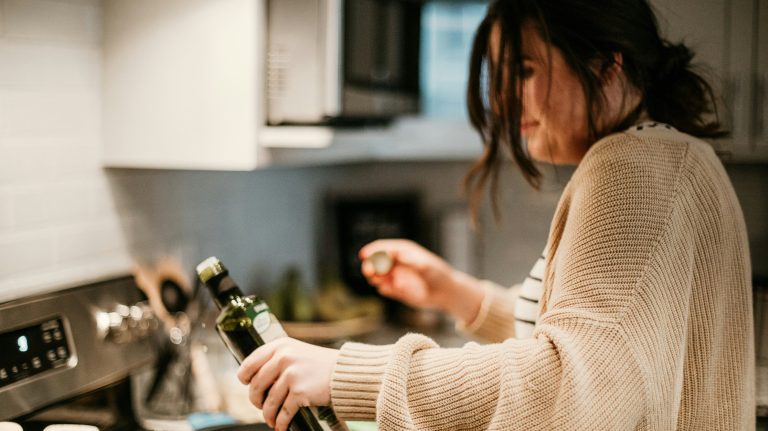Your support changes lives. Find out how you can help us help more people by signing up for a subscription
Lower your combi boiler’s flow temperature
This is one of the government’s top tips for saving on your energy bills – apparently, it could save you approximately £100 a year.
“Flow temperature” refers to the temperature that your boiler heats water to before sending it to radiators in your house. Ordinarily, gas boilers are set to 80C.
Reducing your boiler’s flow temperature will not reduce the temperature in your home, but it could increase the time it takes for your home to reach the target temperature on your thermostat.
“One of the biggest DIY energy-saving tweaks is to reduce the flow temperature from 80C to 60C or lower if possible,” Jo Alsop of The Heating Hub told the Big Issue. “A report by the Heating and Hot Water Council found that this could save 6 to 8 per cent on fuel bills.”
It’s important to note that you should only adjust the flow temperature if you have a combi boiler.
Advertising helps fund Big Issue’s mission to end poverty
“If you’ve got a boiler with a separate hot water tank we don’t recommend it because this could allow bacteria to grow,” said Madeleine Gabriel, director of sustainable future at the innovation foundation Nesta.
“But if you’ve got a combination boiler that provides heating and hot water on demand, which 15 million people do, then this is worth trying.”
People over 65, or with pre-existing health conditions, may want to set a slightly higher flow temperature before lowering it further to ensure your home warms up quickly enough.
The Heating Hub and NESTA have online resources to assist you in adjusting your boiler’s flow temperature.
Reduce washing machine temperature and number of washes
Ofgem advises: “Reducing the temperature and number of washes can help you save money. Changing from 40C to 30C means you could get three cycles instead of two using the same amount of energy depending on your washing machine.”
Modern washing machines can clean clothes effectively at lower temperatures. You should fill the appliance fully each time to reduce the number of washes.
Advertising helps fund Big Issue’s mission to end poverty
It’s also a good idea to reduce the amount you use your tumble dryer, because these are one of the most energy intensive devices in the home. You can make sure you have a full load or use an air dryer and dry your clothes outside.
Turn off your boiler’s preheat setting
Another tweak you can make to your boiler to save energy is turning off the preheat setting.
Some boilers will use a preheat function to keep some hot water pre-prepared to cut the time it takes for hot water to come out of your taps.
In order to do this, the boiler will fire itself up every 90 minutes, using a lot of gas in the process.
If there are times you’re not in the house, or asleep, you should consider switching off your pre-heat setting for these periods.
“If you have a Worcester, Vaillant or Ideal combi boiler, you could save another 5 to 10 per cent on your energy bills by turning off your preheat,” Alsop says.
Advertising helps fund Big Issue’s mission to end poverty
The Heating Hub has an online resource to show you how to turn the preheat setting off.
Draught-proof your doors, windows and chimney
It’s estimated that around 15 per cent of heat lost from an average home is down to draughts.
The Energy Saving Trust says that draught-proofing around windows and doors alone could save a typical gas-fuelled, semi-detached home around £30 a year. Filling the chimney with a chimney balloon, available from most DIY stores, when you’re not using it could save an extra £20 a year in the same property type.
The government goes further and says draught-proofing your home will reduce your energy bills by £60 a year.
While professional draught-proofing could cost around £225 for your whole house, you can do it yourself.
Advertising helps fund Big Issue’s mission to end poverty
For windows that open, buy draught-proofing strips to stick around the window frame and fill the gap between the window and the frame. Self-adhesive foam strips are cheap and easy to install, or you can get metal or plastic strips with brushes or wipers attached. You just need to make sure the strips are the right size for your window.
Older homes with single glazing might be more difficult to draught-proof and may need professional advice.
The Energy Saving Trust has more info on draught-proofing your windows and doors, and tailored advice for if you live in an old building.
Fit low-cost secondary glazing
Meanwhile, around 10 per cent of heat lost from an average home is through the windows.
Secondary glazing is one way you can reduce this loss and make your home more comfortable.
Of course, if you don’t have the means to install secondary glazing, you can instead add cling film or perspex to your windows at a low cost.
Advertising helps fund Big Issue’s mission to end poverty
The Centre for Sustainable Energy provides a range of options for fitting secondary glazing ranging in cost, complexity and permanence.
Get the latest news and insight into how the magazine is made by signing up for the Inside Big Issue newsletter
Turn your thermostat down by one degree
The Centre for Sustainable Energy says turning your thermostat down by one degree could save 10 per cent on your bills.
If your heating system has a main heating thermostat, or a programmer where you can set the temperature, then this is the most important part of your heating system to get to grips with.
Try turning the temperature down by one degree, wait for a day and see how it feels, the website Simple Energy Advice suggests.
Uswitch also says that upgrading to a smart thermostat could also save you as much as £164 a year.
Advertising helps fund Big Issue’s mission to end poverty
This is because it will connect your heating system to the internet meaning you can remotely control your home’s temperature from your phone. So you can save energy and money by turning temperatures down when you’re out of the house. Different smart thermostats range from about £150 to £300.
Ofgem suggests you reduce your thermostat control to 18C to 21C, as the UK Health Security Agency recommends a minimum indoor temperature of 18C to ensure you protect your health and wellbeing whilst maintaining comfort.
Use thermostatic valves on radiators (TRVs)
TVRs allow you to heat individual rooms, meaning they can save you money, says website Plumbcare.
This means you can turn down radiators when rooms aren’t in use, and the government says it could save you £70 a year.
“In these situations, you could reduce the valve low enough to prevent any damp or condensation problems occurring and turn it back up when needed,” National Energy’s Action Project development manager Maureen Fildes said.
You should aim for the lowest setting that keeps the room to your desired temperature. A lower setting reduces the volume of hot water, using less energy and saving you money.
Advertising helps fund Big Issue’s mission to end poverty
It costs around £500 to install TRVs in a whole house so it would take a while to recoup these costs though you would find it saves you money in the long term.
Insulate your hot water tank
You can check if you have a hot water tank by using the Money Saving Boiler Challenge. If you have one, consider investing in a hot water cylinder jacket, available in most hardware stores and online.
If you have a hot water boiler, insulating the water tank is a quick and easy win when it comes to saving money on your bills.
The Energy Saving Trust recommends your boiler’s jacket be 80mm thick. A hot water cylinder jacket costs about £17, fitting it is straightforward if you follow the manufacturer’s instructions and it could save you around £35 a year, according to the Energy Saving Trust.
Move furniture away from radiators
Large pieces of furniture next to radiators soak up huge amounts of heat, so move them away to enable hot air to circulate around your room.
Moving your sofa six inches away from the radiator could save you up to 10 per cent on your bills.
Advertising helps fund Big Issue’s mission to end poverty
Switch off standby
You could save up to £65 per year just by turning your appliances off standby mode.
Almost all electrical appliances in your home, such as computers, televisions, smart devices and video game consoles, draw power continuously unless unplugged.
Most appliances can be turned off at the switch without disrupting their settings – though check the instructions for any you aren’t sure about.
You can buy a standby saver or a smart plug which can help save time by switching all appliances off in one go. Turning devices to “energy-saving” or “eco” mode is another way to reduce energy consumption.
Close all curtains and blinds at night
Ofgem advises people to close their curtains and blinds as this may reduce warm air escaping through the windows at night. It’s particularly important if your radiator is below the window. Closing the curtains will help the warm air stay inside for longer and reduce your heating costs.
Switch to energy efficient bulbs
Lighting makes up 11 per cent of the average UK household electricity consumption. The Energy Savings Trust has found energy efficient lighting helps lower electricity bills and carbon dioxide emissions, all without reducing the quality of light in our homes.
Advertising helps fund Big Issue’s mission to end poverty
The amount of light that bulbs emit is not linked to their energy usage, which means you can get the exact same colour or amount of light in your room at a much lower energy cost.
If you replace all the bulbs in your home with LED lights, you could reduce your carbon dioxide emissions by up to 40kg a year. This is equivalent to the carbon dioxide emitted by driving your car approximately 145 miles.
You can find a handy guide to the best light bulbs for you on the Energy Saving Trust’s website.
Check in with your neighbours
It’s also important to check in with elderly or vulnerable neighbours to see if you can help implement the above measures.
“Check in with neighbours and see if there’s any way you can help them,” Rachel Moffat from Bristol Energy Network told the Big Issue. “This winter’s going to require a team effort.”









